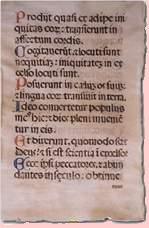CRIBBING & OTHER CHEATING (19 february 2004)
When students are asked to learn a certain amount of theory and they know they are going to be tested, a number of them will usually try to resort to cheating.
Of course, it's up to the teacher to prevent this. Let's see if we can categorize a few of the most common cheating techniques.
Elementary: the mini cheat sheet
A common device employed for cheating purposes is a tiny paper with text in almost microscopic letters. Before the invention of the copying machine, making such papers used to be a handicraft mastered by very few. Nowadays, you can use a copier: just set the machine in reduction mode and feed the copy a few times as original -- and there's your cheat sheet!
 cheat-sheet
& stamp (for size)
cheat-sheet
& stamp (for size)
The loaded pen
The cheat sheet is not necessarily made by the student that needs it. If students are given ample time for a test, a good student can write the answers on a small piece of paper and then pass it on to a less gifted (or lazier) fellow student. This transfer can, for instance, be carried out when the better student leaves the classroom. If dictionaries or other aids are permitted, the paper can be hidden in such an article. I once witnessed a ballpoint-pen with a rolled-up cheat-sheet inside being passed in such a way.
The pivoted card
If the classroom is equipped with wooden tables, a card (with the desired text) is attached to the underside of the tabletop by means of a thumbtack. When the coast is clear, the student pivots the card from under the table so that it becomes visible. At the approach of the teacher, the card is pivoted back out of sight.
The semi-transparent bag
With the advent of plastic shopping bags came a completely new possibility: a paper inside a plastic bag is normally invisible. But if you stretch the plastic over the paper, any text that's on the paper will become visible. You can imagine how this phenomenon can be exploited for cheating purposes.
plastic bag with text
The paper cushion method
This method is classical, not to say old-fashioned. The paper that the student wishes to consult is used like a (rather flat) cushion for the student to sit on. Spreading the legs will expose the paper. A clear disadvantage is that standing up will inevitably reveal the corpus delicti. The teacher can invite the student to stand up, or just wait patiently (and cruelly) till the test is over. I've seen quite a few students trying to conjure their paper out of sight - but never successfully.
CAC (Computer Aided Cribbing)
These days, the computer can be used as a testing device. Of course, such advanced technology also offers ample cheating options to the student. The simplest is when the Internet is accessible. The student can get in touch with an accomplice, for instance by means of e-mail or services like MSN or Yahoo.
The possibilities offered by the computer are almost endless. A text that the student wants to consult can be stored under a name which would even fool an expert. A simple rule of thumb: if the Windows taskbar is hidden (dragged down), it may usually be assumed that something is amiss.
Needless to say that comparable cheating techniques can be used with cellular phones and programmable calculators.
Methods connected with the body
A well-known, albeit rather primitive, method involves the student turning his eyes so that he can see the work of the student sitting next to him. Some students are so adroit at this that if their limbs possessed a comparable mobility, they would be a great success in the circus. If the teacher suspects that a student has (and uses) this gift, the only solution is having the student sit at least eight feet away from any of his neighbours -- which can present a problem in a cramped classroom.
Or what to do when students say they need to visit the toilet? When I started teaching, such visits were simply not allowed. Unless the school has strict rules on this point, I'm afraid such visits will increasingly be abused for other purposes than just sanitary ones.
In the Middle Ages text was often written on the skin of a sheep or goat, usually referred to as parchment.
 skin with text
skin with text
Some students seem to write notes on their own skin. To be honest, I wouldn't know what measures a teacher could take to prevent this. Fortunately, living skin is not an ideal medium to write a lot of text on. Smooth-skinned students seem to have an advantage here.
Conclusion
The methods mentioned here are just a few of a wide range of possibilities that students who wish to cheat have at their disposal.
But teachers, don't despair: most cheating students betray themselves through their body language. And just like not all offenders can be apprehended on the road, a teacher will never be able to eradicate all forms of cheating.
But that doesn't mean the teacher should not try.